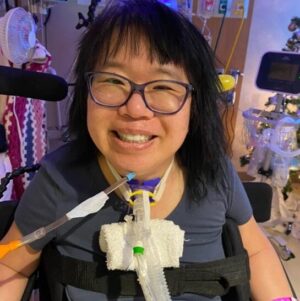Fifty-seven-year-old Stephany Golden has been living with a spinal cord injury since a 2015 accident. We asked his wife and caregiver, Katrina, to explain how mobility intersects with their daily life and how they find the financial and spiritual support they need to keep moving forward.

Mobility Challenges Then and Now
We faced a lot of mobility challenges right after Stephany’s injury.
The biggest challenges involved toileting and transfers: we used a Hoyer lift because he was not able to get to the bathroom by himself. Pre-injury, he was the only driver in our family, so having to arrange transportation for both of us became a challenge.

Today, we face the challenge of finding a place where he can sleep and sit comfortably on a regular basis. He can’t sleep in a hospital bed or in a regular chair without discomfort, so he sleeps in his lift chair—he has been doing so for about four years.
Stephany is also moving less than he was in the beginning, because he is experiencing elevated levels of chronic nerve pain on a regular basis. The pain makes his leg muscles super-tight, and it’s a balance of figuring out how to manage the pain and still participate in therapy.
Physical Therapy and Future Mobility
Doctors tell us that inpatient rehabilitation is his best chance of reducing the pain’s impact on his life—however, the rehab is outside of our health insurance network.
Ultimately, his mobility has decreased over time as he has had more pain to contend with and reduced access to consistent physical therapy.

The lack of access to therapy is primarily due to insurance changes that leave a big out-of-pocket financial burden.
It’s likely that his mobility will continue to decrease over time if he does not get the chance to pursue more intensive rehab. If he does access inpatient rehab, he will have to continue diligently with physical therapy afterwards to maintain the mobility that he achieves.
The Complex Role of a Caregiver
As Stephany’s wife, I tend to try to do everything I can to help him get the services he needs to better himself.

As a caregiver, I spent the early period after his injury focusing entirely on him—as a result, I allowed myself to be neglected with my own medical challenges.
One example of daily mobility challenges is his daily exercise. I have to encourage him to do the exercises that are given to him by his therapist, and if he forgets, it is up to me to help him remember. However, as his pain has increased, I see how much he struggles to do any exercises at all, which is difficult to see. That’s one way mobility intersects with both of our lives on a daily basis.

What I Wish I Could Change
If I could tell the government one thing, I would tell them to pay family caregivers a full-time wage for being the sole supporter for their loved one. I would also ask them to advocate for insurance to pay for a home health aide to help each person with a spinal cord injury with personal care needs. I’d ask them to help prohibit the clause in a life insurance policy that denies a spinal cord patient coverage for final expenses.

Spinal cord injury patients live a long life and often deal with pain.
They should not be denied any supportive benefits just because of a wheelchair or a stereotype.

Out-of-Pocket Mobility Costs We Face
Mobility is a big focus as we continue fundraising.
We need a wheelchair accessible vehicle with hand controls for Stephany to drive—he’s already been approved to drive again through vocational rehab. However, because he needs help with his toileting routine, we cannot get coverage for a vehicle through that program. Even still, Stephany would not be able to pursue work outside of his home.
The therapies we need are inpatient physical and occupational therapy. Alongside that, we need programs that will allow him to use his voice to interact with the computer. With this technology, he will need to get help from a hands-on trainer to walk him through each step so he can use it for both work and personal use.

All of these mobility needs come with a cost.
Insurance pays some of them at 80%, leaving us with 20% to cover out-of-pocket. In addition to mobility costs, we’ve had to cover a hospital bed mattress, lift chairs, home modifications, massage therapy, braces, heating pads, home care aides, and so many co-pays.
How Fundraising Helps with Mobility Expenses
Fundraising with Help Hope Live plays a vital role in us getting the things that insurance does not pay for.

Most of the time, when an accident like Stephany’s occurs, it changes a family’s entire life. You expect family to be your core source of support or place to go for help—after a medical event like this, you can learn where else to find that critical support.
Help Hope Live allows us to fundraise under a 501(c)(3) status. Without that status, our fundraising would be counted against us for benefits purposes based on the government’s limitations on income.
Being a Help Hope Live Ambassador allows me to get the word out that there is a platform that others like me can use to help obtain the funds they need in a traumatic situation.

Being able to collect donations and host events using this trusted nonprofit platform is a proven way to raise funds.
Finding Community Support and Hope for Our Future
Beyond financial help, we get community support in other ways: our church community provides prayer and fellowship. This life with a spinal cord injury often keeps us isolated from the friends we had pre-injury. Most of them now keep their distance, and that can make this life so much lonelier.

However, we have new friends in our community and church who have come into our lives and given us that moral support. As a caregiver, their support also means I can take more quality time for myself just to recharge.
When it comes to the future of Stephany’s mobility and our life , my hope is the plan that Jesus my Savior has for me and for us. We hope to have Stephany around for a long time so that we can grow old together.

I keep that faith, no matter what.
I expect our life to be a testimony on what God can do. Even if we do not get the healing we are praying for, we believe in it for someone else, and above all we trust His plan.
Last Thoughts: My Advice for Other Caregivers
Being a wife and caregiver has changed my life.
I’d like to offer this insight for other caregivers: allow yourself to take the time you need to heal, both physically and emotionally. If you need time to be alone, take that time, and do not take it out on the person with the injury.

Please get in a support group and develop the willingness to share your experiences. Know that life is not over: there are many resources available to help if you just ask.

May 18 marks 5 years with Help Hope Live for Stephany and Katrina. We’re grateful to the Golden family for participating in Mobility Awareness Month and being dedicated Help Hope Live Ambassadors. Connect, stay tuned, and make an impact by visiting his Campaign Page.
Written by Emily Progin










